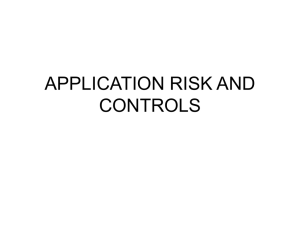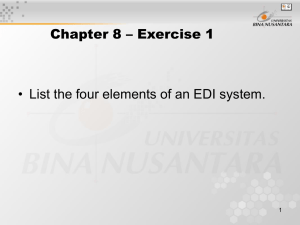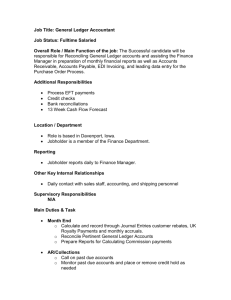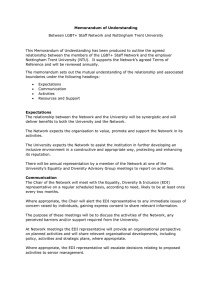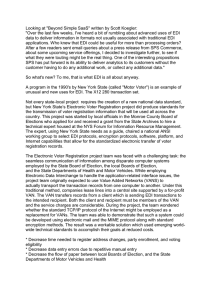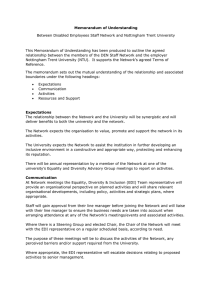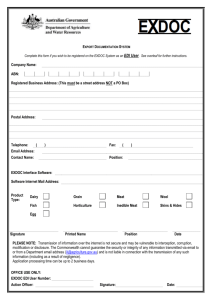Property Driven Innovation of a Technical Product
advertisement
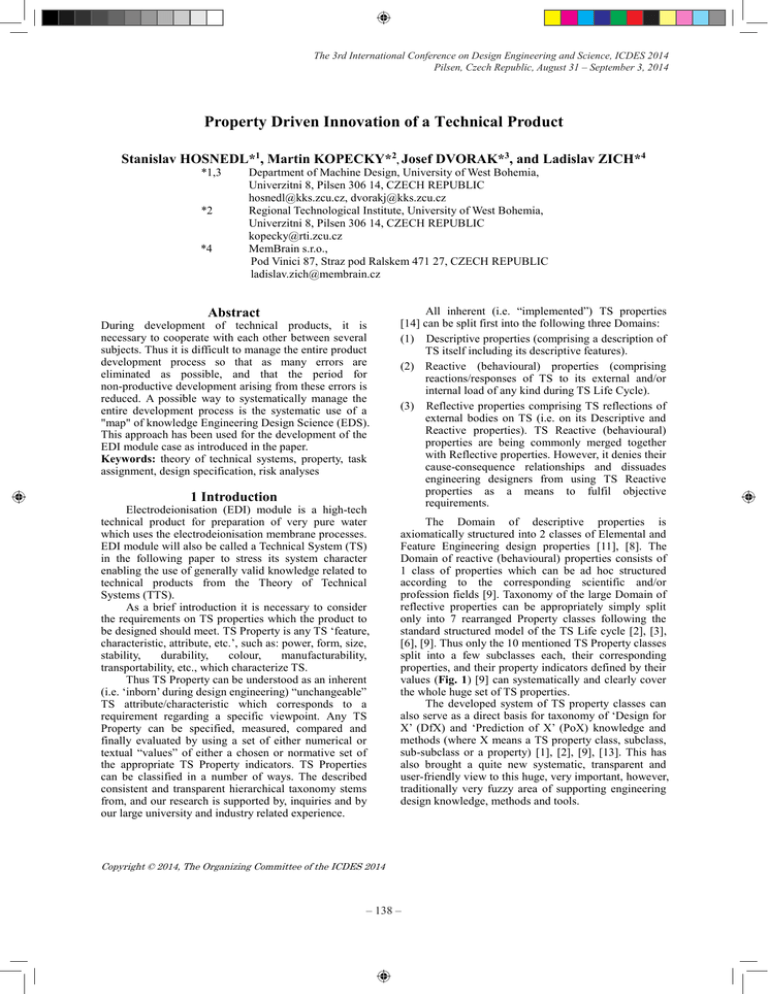
The 3rd International Conference on Design Engineering and Science, ICDES 2014 The 3rd International Conference on Design and September Science, ICDES 2014 Pilsen, Engineering Czech Republic, 1-3, 2014 Pilsen, Czech Republic, August 31 – September 3, 2014 Property Driven Innovation of a Technical Product Stanislav HOSNEDL*1, Martin KOPECKY*2, Josef DVORAK*3, and Ladislav ZICH*4 *1,3 *2 *4 Department of Machine Design, University of West Bohemia, Univerzitni 8, Pilsen 306 14, CZECH REPUBLIC hosnedl@kks.zcu.cz, dvorakj@kks.zcu.cz Regional Technological Institute, University of West Bohemia, Univerzitni 8, Pilsen 306 14, CZECH REPUBLIC kopecky@rti.zcu.cz MemBrain s.r.o., Pod Vinici 87, Straz pod Ralskem 471 27, CZECH REPUBLIC ladislav.zich@membrain.cz Abstract During development of technical products, it is necessary to cooperate with each other between several subjects. Thus it is difficult to manage the entire product development process so that as many errors are eliminated as possible, and that the period for non-productive development arising from these errors is reduced. A possible way to systematically manage the entire development process is the systematic use of a "map" of knowledge Engineering Design Science (EDS). This approach has been used for the development of the EDI module case as introduced in the paper. Keywords: theory of technical systems, property, task assignment, design specification, risk analyses 1 Introduction Electrodeionisation (EDI) module is a high-tech technical product for preparation of very pure water which uses the electrodeionisation membrane processes. EDI module will also be called a Technical System (TS) in the following paper to stress its system character enabling the use of generally valid knowledge related to technical products from the Theory of Technical Systems (TTS). As a brief introduction it is necessary to consider the requirements on TS properties which the product to be designed should meet. TS Property is any TS ‘feature, characteristic, attribute, etc.’, such as: power, form, size, stability, durability, colour, manufacturability, transportability, etc., which characterize TS. Thus TS Property can be understood as an inherent (i.e. ‘inborn’ during design engineering) “unchangeable” TS attribute/characteristic which corresponds to a requirement regarding a specific viewpoint. Any TS Property can be specified, measured, compared and finally evaluated by using a set of either numerical or textual “values” of either a chosen or normative set of the appropriate TS Property indicators. TS Properties can be classified in a number of ways. The described consistent and transparent hierarchical taxonomy stems from, and our research is supported by, inquiries and by our large university and industry related experience. All inherent (i.e. “implemented”) TS properties [14] can be split first into the following three Domains: (1) Descriptive properties (comprising a description of TS itself including its descriptive features). (2) Reactive (behavioural) properties (comprising reactions/responses of TS to its external and/or internal load of any kind during TS Life Cycle). (3) Reflective properties comprising TS reflections of external bodies on TS (i.e. on its Descriptive and Reactive properties). TS Reactive (behavioural) properties are being commonly merged together with Reflective properties. However, it denies their cause-consequence relationships and dissuades engineering designers from using TS Reactive properties as a means to fulfil objective requirements. The Domain of descriptive properties is axiomatically structured into 2 classes of Elemental and Feature Engineering design properties [11], [8]. The Domain of reactive (behavioural) properties consists of 1 class of properties which can be ad hoc structured according to the corresponding scientific and/or profession fields [9]. Taxonomy of the large Domain of reflective properties can be appropriately simply split only into 7 rearranged Property classes following the standard structured model of the TS Life cycle [2], [3], [6], [9]. Thus only the 10 mentioned TS Property classes split into a few subclasses each, their corresponding properties, and their property indicators defined by their values (Fig. 1) [9] can systematically and clearly cover the whole huge set of TS properties. The developed system of TS property classes can also serve as a direct basis for taxonomy of ‘Design for X’ (DfX) and ‘Prediction of X’ (PoX) knowledge and methods (where X means a TS property class, subclass, sub-subclass or a property) [1], [2], [9], [13]. This has also brought a quite new systematic, transparent and user-friendly view to this huge, very important, however, traditionally very fuzzy area of supporting engineering design knowledge, methods and tools. Copyright © 2014, The Organizing Committee of the ICDES 2014 – 138 – The outlined TS Property based Task Assignment thus obviously brought to the interdisciplinary and multi-locally solved project transparency and avoided many misunderstandings and evoked errors. 3 TS Property based Task Specification Fig. 1 Taxonomy system for TS Properties - Domains, Classes, Sub-Classes, Properties and their Property Indicators incl. their Values 2 TS Property based Task Assignment The task of EDI module innovative redesign for higher working parameters to increase its competitiveness was established by MemBrain Ltd. at Straz pod Ralskem. The partial task assigned to the research team at the University of Bohemia (UWB) was to achieve innovative design of EDI module case. The case supports the internal EDI module components that are subjected to the working pressure needed for an efficient and effective electrodeionisation process. The case should however meet not only the increased working and assembly requirements assigned by MemBrain Ltd., but also demanding requirements assigned by other involved bodies. The first demanding requirements were assigned by two cooperating experts in the field of membrane processes from the Netherlands and from Canada. Further key requirements were assigned by two selected external manufacturing suppliers: LUKOV PLAST Ltd., a company for manufacturing EDI module internal active plastic components, and METAZ Ltd., a company for manufacturing EDI module case parts. These assigned key requirements on the designed EDI module case were traditionally obtained and then gradually updated on the basis of knowledge and experience of the involved experts. This usual approach however does not guarantee that any (even crucial) request will be disregarded. Thus the UWB research team systematically arranged and gradually updated the unordered set of all the above mentioned assigned requirements according to the above outlined taxonomy of TS properties (see Chapter 1). Each such subset of assigned requirements was accompanied by chronologically arranged copies of emails, records of calls, minutes from meetings etc. clearly documenting each assigned change. This approach proved to be effective, because we, academic researchers, quite simply listed our clearly arranged system of selected questions, and company experts quite simply answered them. It brought a transparent overview of all currently valid assigned data to all involved persons during the whole development process from its very beginning (attached in a form of one of the agreement enclosures) to its very end (attached in a form of one of the project reports). It also served afterwards to clearly differentiate the originally assigned and/or additionally improved, and thus agreed requirements from additionally assigned requirements and thus evoked additional works. 3.1 Product and Patent searches In the early stages of any project it is first necessary to go deep into problem. Because the UWB research team started fully from scratch in the field of EDI modules, it was especially vital to find out all available knowledge about them. Most of this knowledge could be obtained from product and patent searches. Product search enables us to find out what competitive companies are focused on, to learn from them and subsequently try to design a better product. Samples of EDI modules and their producers found during the product search are depicted in (Fig. 2). Fig. 2 Samples of current competitive EDI modules: Module LX30X-3 from Siemens (left) and GE E-Cell*-3XHH from General Electric (right) Patent search using at least public databases is necessary to find out relevant intellectual property rights of the third parties to avoid their infringements. An overview of the protected designs of EDI modules and their details was a result of this partial project. Even if not usually mentioned, the products and patents searches also implicitly significantly serve for completion of other requirements on further TS properties of a designed technical product. The reason is that the assigned requirements (see Chapter 1) are not sufficient to achieve a successful product for its whole Life Cycle (LC). It is also necessary to meet other important obligatory requirements arising from standards, regulations, laws, etc., generally implied requirements (by society, local public, customers, etc.) arising from generally appreciated (by society, local public, customers, etc.) product values, habits, customs, etc. [14]. These “external” requirements can be further completed by the authors’ own “internal” requirements but which could potentially increase product competitiveness on the market [8]. 3.2 Feasibility study Its aims are analyses of viability of a designed technical product from technical (physical), economic (cost sources, profit), financial (starting finance), personal (quantity and quality), etc. viewpoints. It obviously also closely relates to requirements on properties of a designed product. It can significantly affect requirements on values of property indicators. – 139 – Very often the case is a decrease of the required function parameters. Designing the EDI module case was however only a partial task of the innovation project of the EDI module. Thus a feasibility study was performed by MemBrain Ltd., and cannot be included here. 3.3 TS Property based Design Specification At the end of this first Task Specification phase of the engineering design process it is necessary to carefully specify all appropriate requirements which are imposed on the designed technical product during all its Life Cycle (LC) stages. It is however also required to specify selected LC generally invariant requirements concerning constructional structure of the designed technical product and/or requirements on its behaviour/response on a specified load of any kind. As mentioned above, the set of these requirements had to cover not only the above mentioned ones stated by “customer” and focused mostly on operation & maintenance and manufacturing processes, but also other obligatory and/or generally implied requirements [8] and/or even own requirements focused e.g. on use of own patents, etc.. In order to achieve effective and efficient treatment with and optimal fulfilment of the outlined large set of very different kinds of requirements by a designed technical product it is necessary to arrange them. Requirements on a designed technical product obviously relate to “inherent” TS properties (i.e. implemented during designing and not additionally changeable by a decision of anybody afterwards as “assigned” ones). Therefore it was advantageous to arrange the mentioned set of unordered requirements also according to the taxonomy system outlined above for TS properties based on the Theory of technical systems [11] (see Chapter 1). It was thus necessary to get to know and complete requirements for the designed EDI module case. At the beginning of the project all available collected assigned requirements on the designed EDI module case were clarified. The project team was really interdisciplinary. It consisted of about 10 members from 1 research institute, 1 university and 1 industrial design office, cooperating with 2 independent membrane processes experts from abroad and consultants from 2 industrial companies. Naturally, each of them had its own view about the requirements on the designed technical product. In addition it was necessary to complete this set of assigned stated requirements with the above mentioned obligatory, generally implied and also a few own requirements with use of the above mentioned (see Subchapters 2.1 and 2.2) and also other ad hoc available sources. All final selected and clarified requirements on TS properties of the designed EDI module case with use of the developed software tool called SP&HA were implemented in SW MS Excel [10]. It has been utilized and validated in its different development versions in a number of interdisciplinary design projects [3], [5]. Each requirement was specified by values of its established respective property indicators with an assigned importance (weighting) from negligible up to compulsory, numerically expressed from 0 to 4. Thanks to our experienced partners and due to shortage of time we could focus only on key requirements and thus utilize the large potential of SP&HA only partially. In spite of this, it enabled us to evaluate predicted fulfilment of all specified key properties, comparing and evaluating them with specified requirements and possibly also with respective properties of the selected competitive products. Some of the useful features of this SW tool are diagrams supporting SW(OT) analyses. These indicated strong and weak properties as well as corresponding risk indicators [7] of the alternative designs for the EDI module case. SP&HA can also cover the selected competitive products, however it was not used due to lack of appropriate data. The weak properties are needed to be improved as selective disruptive innovations. In general it is possible to specify a very detailed set of transparently arranged requirements. Such a comprehensive specification of requirements thus has a key role for the resulting Life Cycle quality of a designed technical product. Thus the traditional ways of establishing design specification starting from “Trial and Error” approach (i.e. without almost any design specification) through “Intuitive” (usable however only by very experienced experts) up to “Instructive” ones. These are however available only as more or less complete subjective instructions (e.g. in [8] and many others) based on knowledge and experience accumulated by their authors. 4 Search for TS transformation functions and resulting TS organ structure Based on the established design specification we were prepared to establish the process of electrodeionisation in the form of a black box of the operation transformation process of the EDI module (not shown here). Next, we established its necessary main transformation and corresponding assisting functions and prepared to start its conceptual designing in the form of its TS function structure (not shown here) and corresponding alternatives of TS organ structure with use of morphological matrix (Fig. 3). The designed conceptual alternatives of TS organ structures (Fig. 4) were subsequently evaluated and a suboptimal one was selected and further developed (see Chapter 5) 5 TS Property based Search for solutions and their respective evaluations The next “embodiment design” step [2], [3] aiming at alternatives and finally at sub-optimal TS constructional structure including its sub-structures (called here constructional organs) of the designed EDI module optimally utilised all generally known and used solution approaches from the most simple “Trial and Error (and Success!)”, through “Intuitive” and “Instructive” ones until the Theory (EDS-TTS) based ones as e.g. outlined in [5], [9]. The process of achievement of the respective requirements on EDI module properties was accompanied by recorded (explicit) and tacit (implicit) “Design for X” knowledge and methods – 140 – A few examples illustrating the two “coupled steps” i.e. search for solutions of alternatives of the EDI module’s main evoked Constructional Organs [2], i.e. constructional function carriers [13], and their evaluation according to the criteria regarding the main required properties specified in the list of requirements, followed by a decision about the sub-optimal alternative are outlined in (Fig. 5, 6 and 7). Fig. 3 Morphological matrix with established main & assisting TS functions, corresponding TS organs (function carriers), and their selected groupings Alternative solutions of the connections of the EDI module case plates using connections with: A. bolt and pin B. only bolt connections C. bolt and shape lock Fig. 5 EDI module case Constructional Organ for the main Function: Case Plates (their material, energy and information in general) connect together Alternative preliminary solutions of the side plates: A B Fig. 6 EDI module Constructional Organ for the main function: Create working space (an example for its side boundaries is shown) Fig. 4 Examples of alternatives of preliminary organ structures of EDI module case However, necessary evaluation of the designed alternatives and their variants of the EDI module constructional structure including its sub-structures had to be performed again systematically according to the list of requirements to cover all the specified properties [5], [9]. To perform it both recorded (explicit) and tacit (implicit) “Prediction of X” knowledge and methods were utilized. It is advantageous both for designing and its knowledge management that the huge field of generally unordered DfX and PoX knowledge and methods can be also systematically arranged according to the same structure as TS properties and thus also the mentioned list of requirements on properties of a designed product (see Chapter 1). Alternative preliminary solutions: A B C Fig. 7 EDI module aggregated Constructional Organs for the evoked functions: Enable EDI module(s): - manipulate and transport, - vertically and horizontally stack, - and connect with a foundation (not shown) Based on the outlined PoX knowledge and methods, and the multi-criteria evaluation which stemmed from the set of the specified properties the – 141 – alternative C of the connections (Fig. 5) was selected as a sub-optimal (including the not shown simple mutual galvanic connections of all plates). Similarly alternative B (Fig. 6) was selected as a sub-optimal solution for side plates (including the shown appearance [12], and alternative C (Fig. 7) as a sub-optimal one for the depicted multi-purpose constructional organ Table 1 Selected risk indicators of TS properties and investigated consequences/risks 6 TS Property based final analyses and evaluation Finally the whole EDI module Constructional Structure was analysed and sub-optimised regarding the strengths and displacements (Fig. 8), considering all the specified requirements on the required TS properties, especially manufacturability, assembly-ability, mass, industrial design and production cost in this case [4]. Fig. 8 FEM analyses of strengths (left) and displacements (right) for the EDI module case Thus the resulting sub-optimal constructional structure meets systematically assessed requirements and also respects and minimizes possible risks. There are many generally used techniques to investigate and evaluate risks of [15], [16]. In our case we used the generally known and used method FMEA [15]. The degree of potential risks were however again "assessed" for respective TS properties according to their weighting and evaluation of their fulfilment. Then the key indicators of RPN (Risk priority number) were determined (Severity, Detection, Occurrence). The selected crucial consequences are depicted in Table 1. The most dangerous risks which had to be taken into account during designing were: the size of the operating pressure, the size of the test pressure, the amount of pressure from the swelling of ion-exchange balls, sealing of the connection plates, absorption of the power drawn for pressing the sealing between distributors and material properties of plates. Significant risks were also indicated, such as increased nominal flow, other pressure differential at the input and the output, quality of the material and dimensions of plates, comply with the dimensional and material parameters of distributors and membranes. A significant risk is also incurred when complying with standards and non infringement of intellectual property of other parties. – 142 – RISK INDICATOR CONSEQUENCE Nominal flow breach internal component/plates of module/rupture Hydraulic operating pressure breach internal component/plates of module/rupture Hydraulic test pressure breach internal component/plates of module/rupture Pressure difference input/output breach internal component/plates of module/rupture Additional pressure from swelling balls breach internal component/plates of module/rupture Operating temperature destabilisation of deionisation Tightness of plates connection leakage of fluid Absorption of force to push the seals crumbling seal/rupture of internal components Prismatic structure limited disassembly, cost increase Distance from the inner wall of plates Rupture of spacers Parameters of ribs of plates Connection dimensions for input/output of fluids/energy Location of pipe size for input/output of fluids/energy Disassembly of joints Unmanufacturability, increase costs Increase cost of assembly Increase cost of assembly Increase cost of disassembly Drifting between plates personal injury Corrosion of joints deflection of plates Plate material and parameters Rupture of plates Self-supporting Fall of module Foundation connection Overturn of module Flatness of plates Rupture of plates during tighten Param. of distributors and membranes Unable to assembly of module Compress. of active zone Leakage fluid and excessive load Assembly process Leakage fluid and excessive load Tighten connections equipment by the same torque Max. longitudinal extension of active block Detachment of plates Leakage of fluid Max. total lateral extension of active block Leakage of fluid Direct stack Increase storage costs Ease of manipulation Increase costs Industrial design Reduction of competitiveness IP infringement and standard violation Financial compensation, denial certification, increase costs 7 Conclusions Theoretical and practical results of the developed methodology based on TS property driven designing in the challenging area of designing an EDI module case are presented in the paper. Use of such theoretically based approaches and tools was not easy for the industrial partners. However, keeping a systematic knowledge base without bothering the involved, highly experienced partners obviously proved to be useful. Acknowledgements This paper includes partial results from the Project SGS-2013-050 “Complex support of design engineering of technical products to improve their properties and competitiveness II”. We also would like to greatly thank the company management of MEGA a.s. at Straz pod Ralskem (CZ), submitter of the development of EDI modules and to its experts, especially to Ing. Jiri Lipa; to company and project management and experts of MemBrain Ltd. at Straz pod Ralskem (CZ), carrier of the project, especially to Ing. Luděk Janik, Ing. David Tvrznik, as well as to Ing. Zbynek Petras during the final development and prototype manufacturing phases. Last but not least we greatly appreciate the fruitful cooperation of the hired designers MgA. Daniel Pavlík and MgA. Jan Kopriva from Praha (CZ) for their attractive industrial designs, and Ing. Karel Raz from the University of West Bohemia in Pilsen (CZ) for his professional FEM analyses. References [1] Birkhofer, H. Editor: The Future of Design Methodology. London: Springer, (2011), pp.1-18. [2] Eder, W. E., Hosnedl, S.: Design Engineering - A Manual for Enhanced Creativity. CRC Press, Taylor & Francis Group, Boca Raton, Florida USA, (2008) pp.61-75, 133-176. [3] Eder, W. E., Hosnedl, S.: Introduction to Design Engineering: Systematic Creativity and Management. CRC Press / Balkema, Taylor & Francis Group, Leiden, The Netherlands, (2010), pp.61-75, 133-176. [4] Ehrlenspiel, K., Kiewert, A., Lindemann, U. CostEfficient Design. M. Hundal ed. Berlin: Springer-Verlag, (2007), pp.190-262. [5] Hosnedl, S., Srp Z., Dvorak, J.: Cooperation of Engineering & Industrial Designers on Industrial Projects", Proc. of the 10th Int. Design Conf. DESIGN 2008. Zagreb, (2008), pp. 1227 – 1234. [6] Hosnedl, S., Srp Z.: Effective engineering design research, education and practice in context. In: Proceedings of the 2nd International Design Conference on Design Engineering and Science ICDES 2010. Eds. K. Watanuki and T. Kanada. Tokyo, Japan: (2010), pp. 80-85. [7] Hosnedl, S., Kopecky M., Dvorak, J.: Enhanced Product Design Specification for Prediction of Design Competitiveness and Inherent Risks of Designed Technical Products. In: Proceedings of 52. International scientific conference of departments of machine elements and mechanisms. Ostravice: VŠB-TU Ostrava, (2011), pp. 85-90. [8] Hosnedl, S.: System designing of technical products (in Czech). Pilsen: University of West Bohemia, (2012) (electronic version). [9] Hosnedl, S., Dvorak J., Kopecky M.: Integrated Engineering Design Research and Interdisciplinary Education in cooperation with Industrial Partners. Proceedings of The 3rd Int. Symposium on Integrating Research, Education, and Problem Solving: Summer IREPS 2013. Orlando, Florida USA: (2013), ), p. 218-223. [10] Hosnedl, S.: Specification of requirements regarding the designed technical product TS(s) with evaluation and analyses of their fulfilment incl. risk indication. http://home.zcu.cz/~hosnedl, SW MS EXCEL, Pilsen: University of West Bohemia, (2013) [11] Hubka, V. , Eder, W.E.: Theory of Technical Systems. Berlin: Springer, (1988), pp.112-143. [12] Kopecký, M., Raz, K., et al.: „Design Engineering solution of mechanical case of electrodeionisation (EDI) module incl. conception of covers“. (in Czech) EDI-ZČU-2013-06-01. University of West Bohemia, (2013). [13] Pahl, G., Beitz, W., Feldhusen, J. and Grote K.H.: Engineering Design, A Systematic Approach. Third English edition. London: Springer, (2007). (Transl. K. Wallace, L. Blessing from: Pahl, G. et al. from Konstruktionslehre, Berlin: Springer-Verlag, (2003) ), pp. 308-410. [14] CSN EN ISO 9000 Czech v. of the European Standard Quality management systems Fundamentals and vocabulary. Praha: Czech Institute for Standardization, (2006), p.19. [15] CSN EN 60812 Czech v. of Analysis techniques for system reliability - Procedure for failure mode and effects analysis (FMEA). Praha: Czech Institute for Standardization, (2007), pp. 1-44. [16] CSN EN 310102 Czech v. of Risk management Risk assessment techniques. Praha: Czech Institute for Standardization, (2011), pp.1-80. Received on February 7, 2014 Accepted on February 24, 2014 – 143 –


